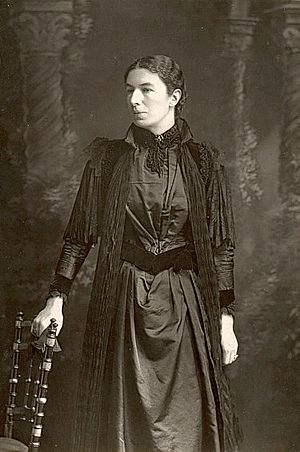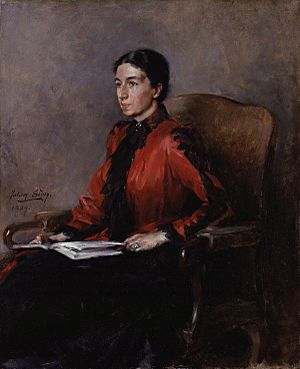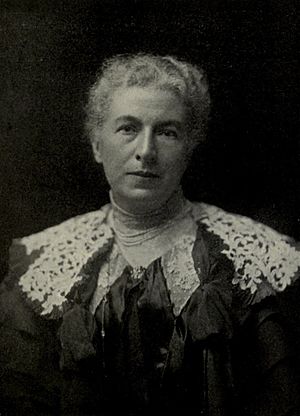Mary Augusta Ward facts for kids
Quick facts for kids
Mary Augusta Ward
|
|
|---|---|
 |
|
| Born | Mary Augusta Arnold 11 June 1851 Hobart, Tasmania, Australia |
| Died | 24 March 1920 (aged 68) London, England |
| Pen name | Mrs. Humphry Ward |
| Nationality | British |
| Spouse | Thomas Humphry Ward |
| Children | Arnold Ward Janet Trevelyan |
| Relatives | Tom Arnold (father) |
| Signature | |
Mary Augusta Ward CBE (born Mary Augusta Arnold; 11 June 1851 – 24 March 1920) was a British novelist. She wrote her books using her married name, Mrs Humphry Ward.
Mary worked hard to improve education for people who were poor. She also became the first president of the Women's National Anti-Suffrage League. This group was against women getting the right to vote.
Contents
Early Life and Family
Mary Augusta Arnold was born in Hobart, Tasmania, Australia. She came from a very smart family of writers and teachers. Her father, Tom Arnold, was a literature professor. Her uncle was the famous poet Matthew Arnold. Her grandfather, Thomas Arnold, was the well-known headmaster of Rugby School.
Mary's sister, Julia, started a school. Julia married Leonard Huxley. Their sons, Julian and Aldous Huxley, became famous too. The Arnold and Huxley families were very important in British intellectual life.
Mary's father, Tom Arnold, became a school inspector in Tasmania. In 1856, he joined the Roman Catholic Church. This made him very unpopular at his job and with his wife. So, he quit and moved his family to England in July 1856. Mary was five years old when they left Tasmania. She never went back.
Education and Marriage
Mary spent a lot of time with her grandmother. She went to different boarding schools from ages 11 to 15. At 16, she moved back to Oxford to live with her parents. Her father was teaching history there. Her experiences at school later inspired her novel, Marcella (1894).
On 6 April 1872, Mary married Humphry Ward. He was a writer and teacher at Brasenose College. For the next nine years, she lived in Oxford. She learned many languages, including French, German, Italian, Latin, and Greek. She also started to get interested in helping society and education.
Supporting Women's Education
Mary Ward strongly supported women being able to study at Oxford University. She was part of a group that organized lectures for women. This group also helped create the Association for the Education of Women. This association worked to open special places for women students in Oxford.
Ward was very involved in starting Somerville College in Oxford in 1879. She suggested naming it after Mary Somerville, a famous scientist. Ward became the first secretary of the Somerville Council. She helped prepare for the first students, even though she was eight months pregnant!
Writing Career
Mary Ward started her writing career by writing articles for Macmillan's Magazine. She also wrote a book for children called Milly and Olly in 1881. In 1884, she wrote Miss Bretherton, a story about an actress.
Ward's novels often explored strong religious ideas that were important in Victorian times. Her books became popular not just in Britain, but also in the United States. Her book Lady Rose's Daughter was the best-selling novel in the U.S. in 1903. The Marriage of William Ashe was also a bestseller in 1905.
Her most famous novel was Robert Elsmere. This book was about a young pastor and his wife. It explored how new ideas about religion affected people's faith. The book made many people discuss Christianity and its history.
Social Work and Activism
Mary Ward helped create groups to work with and teach people who were poor. She also worked as a teacher in special community centers she founded. These centers were called "settlements." Mary Ward wanted to make society more equal.
She started educational settlements first at Marchmont Hall. Later, she opened what is now called Mary Ward House in Bloomsbury, London. This center was first named after its supporter, John Passmore Edwards. After Ward died, it became the Mary Ward Settlement. Today, it is known as the Mary Ward Centre. It is still an adult education college. The Mary Ward Legal Centre, which helps people with legal problems, is also connected to it.
Against Women's Vote
Mary Ward was also a strong campaigner against women getting the right to vote. In 1908, she was asked to be the first president of the Women's National Anti-Suffrage League. Ward took on this role. She created and edited the Anti-Suffrage Review.
She wrote many articles about why she was against women's suffrage. Two of her novels, The Testing of Diana Mallory and Delia Blanchflower, also shared her views. In a 1909 article, Ward wrote that only men could solve big problems like those related to government, money, military, and international issues. However, she did support women having a say in local government and other rights that some men in the anti-suffrage movement did not agree with.
World War I Efforts
During World War I, former U.S. President Theodore Roosevelt asked Ward to write articles. These articles would explain to Americans what was happening in Britain. For this work, she visited the trenches on the Western Front. Her experiences led to three books: England's Effort - Six Letters to an American Friend (1916), Towards the Goal (1917), and Fields of Victory (1919).
In 1919, Mary Ward was honored for her work. She was made a Commander of the Order of the British Empire.
Personal Diary
Throughout the 1880s, Mary kept a secret personal diary. In it, she wrote social and literary stories about the people she knew. She wanted her observations to be anonymous, so the diary was not published while she was alive.
After Mary's death in 1921, the diary was published. It was still anonymous and called Echoes of the 'Eighties: Leaves from the Diary of a Victorian Lady. It wasn't until 2018 that people discovered Mary Ward was the author.
Death
Mary Augusta Ward died in London on March 24, 1920. She was buried in Aldbury, Hertfordshire. This was near her beloved country home, Stocks.
Selected Works
- Fiction
- (1881). Milly and Olly.
- (1884). Miss Bretherton.
- (1888). Robert Elsmere.
- (1892). The History of David Grieve.
- (1894). Marcella.
- (1895). The Story of Bessie Costrell.
- (1896). Sir George Tressady.
- (1898). Helbeck of Bannisdale.
- (1900). Eleanor.
- (1903). Lady Rose's Daughter.
- (1905). The Marriage of William Ashe.
- (1906). Fenwick's Career.
- (1908). Diana Mallory.
- (1909). Daphne, or 'Marriage à la Mode'.
- (1910). Canadian Born.
- (1911). The Case of Richard Meynell.
- (1913). The Mating of Lydia.
- (1913). The Coryston Family.
- (1914). Delia Blanchflower.
- (1915). Eltham House.
- (1915). A Great Success.
- (1916). Lady Connie.
- (1917). Missing.
- (1918). The War and Elizabeth.
- (1919). Cousin Philip.
- (1920). Harvest.
- Non-fiction
- (1916). England's Effort, Six Letters to an American Friend.
- (1917). Towards the Goal.
- (1918). A Writer's Recollections.
- (1919). Fields of Victory.
- Translations
- (1885). Amiel's Journal: The Journal Intime.
Film Adaptations
Mary Augusta Ward's novels were made into films:
- The Marriage of William Ashe, (1916)
- Missing, (1918)
- Lady Rose's Daughter, (1920)
- The Marriage of William Ashe, (1921)
Images for kids
See also
 In Spanish: Mrs. Humphry Ward para niños
In Spanish: Mrs. Humphry Ward para niños





